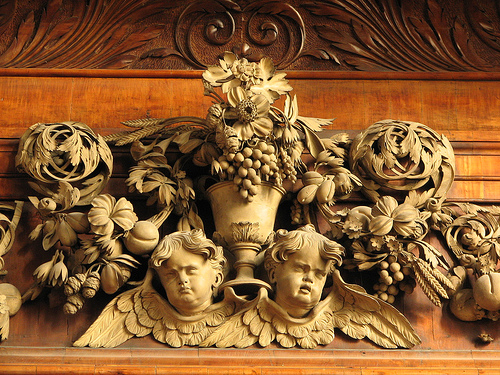At a glance there is little to parallel the lives and work of either Grinling Gibbons, a seventeenth century English woodcarver and Anselm Kieffer the German contemporary whose Retrospective at the Royal Academy London, is the current art hot ticket.
The possibility to see both artists in the space of two days, is testament to the extraordinary cultural depth London draws upon.
The present and the past mingle seamlessly, one informing the other. Both engage the mind across time.
After the Church of England’s sixteenth century, split from the Roman Catholic Church, Gibbons profound gifts for figurative wood carving were left without a market. After considerable struggle, he invented an entirely new form of apparently decorative, flora and fauna high relief Limewood carving, which in its crisp sensitivity, is simply breathtaking. I say “apparently ” because on close inspection, those quivering transformations of nature, which set this work apart, impart a deep human presence. One that transcends the period in which it was created.
I was drawn to this work by happenstance, after reading David Esterley’s The Lost Carving, about the year he spent carving anew, the Gibbons over mantle piece, in the William the Third rooms, destroyed by the fire that devastated Hampton Court in 1986. Esterley in effect enters into the mind of Gibbons, studying his methodology in order to recreate it. I look forward to meeting him later in this journey, in his studio, in Barneveld, New York State.
Esterley’s book is that rare thing, an illuminating, highly engaging text, by an artist, detailing the rich process that supports and sustains, the creation of his work.
Kieffer’s major retrospective in the Royal Academy has not yet undergone the same examination by time, Gibbons has with-stood. For now, he is a major international artist whose dramatically arresting paintings, sculptures and books give powerful voice to the trauma of a post WW 11 German/European cultural legacy.
Like Gormley, in my previous post, Kieffer creates vast, authoritative museum scale works, that draw on commensurate resources. In the latters’ case, there is a Wagnerian seriousness and theatrically in his presentation. These are portentious, visceral creations, caked in the grim debris of the history they evoke. Unlike Gibbons there is no place for repose, in the urgency and assertiveness, Kieffer confronts us with.
In Kiefer’s cosmology, the universe is an immense alchemical oven in which spirit and matter find themselves in a continuous process of creation and destruction.
Perhaps this is the inevitable process, time undertakes on all things, something those Gibbons carvings saved from a fires ravages, might also attest to?

